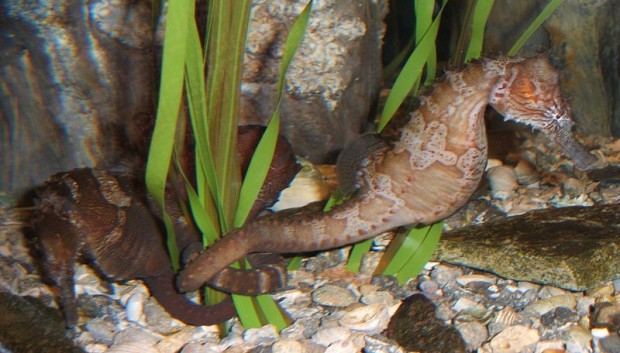Island’s Enchanting, Endangered Seahorses
 It’s easy to understand why Bermuda’s endangered seahorses remain an enduring source of fascination: with a head like a horse, a snout like an aardvark a prehensile tail like a monkey and the ability to change colours like a chameleon, the seahorse is anything but ordinary.
It’s easy to understand why Bermuda’s endangered seahorses remain an enduring source of fascination: with a head like a horse, a snout like an aardvark a prehensile tail like a monkey and the ability to change colours like a chameleon, the seahorse is anything but ordinary.
And perhaps what most distinguishes seahorses from the rest of the animal kingdom is their unique life history — the males become pregnant and give birth
Sadly, the mystique which draws people to seahorses is the reason they are in jeopardy in both Bermuda’s waters and globally.
Of the 34 known seahorse species, eight are included on the International Union for the Conservation of Nature’s “Red List” of threatened animals.
A number of factors are contributing to the decline of seahorse populations worldwide: loss of coral reefs and coastal habitats, harming fishing practices which lead to seahorses being netted as by-catches and the excessive collecting of seahorses.
While seahorses are not common in Bermuda’s waters, three species have been recorded locally: the Longsnout Seahorse, the Lined Seahorse and the Dwarf Seahorse.
They can be found in seagrass beds and algae-covered bottoms, where they wrap their tails around a plants for support and use their colouring to blend with their environment to avoid detection by predators.
Seahorses can also be seen on mooring lines and around docks. Unlike other fish, seahorses don’t have scales. Instead they have bony plates covered by a thin skin.
They also don’t have teeth or a fully developed digestive system. Seahorses have fused jaws and eat small crustaceans and plankton by sucking the prey into their mouths and swallowing it whole.
Seahorses engage in elaborate courtship rituals before they mate –- sometimes lasting for three days. Each morning during the breeding season a seahorse pair greets and signals interest in each other by displaying bright colours, intertwining tails, twirling around and promenading side by side.
If the pair finally decides to mate, they’ll join together and rise in the water column as the female deposits her eggs into the male’s brood pouch where they are fertilized. Competition is fierce and seahorse species are known to fight over mates.
In Bermuda, the Longsnout and Lined Seahorses [pictured above] are both protected under the 2003 Protected Species Act. The Dwarf Seahorse has not been seen in Bermuda since 1905 and is assumed to have become locally extinct.
In 1999, a study was proposed by the Bermuda Aquarium, Museum & Zoo to collect baseline information on the Bermuda seahorse population in order to make an assessment of the population’s size, health, habitat and geographic range.
Most of what is knowm about Bermuda’s seahorse population is based on anecdotal information, but from this information it appears seahorses were far more abundant in Bermuda’s waters in the past. In order to take into account any seasonal variations, the survey of habitats began in January, 2000 and continued for the duration of the year. In all 39 sites were surveyed and included a mix of habitats such as sea grass beds, moorings, docks, and bays.
The Bermuda survey’s findings mirrored the global trend of declining seahorse populations
Read More About
Category: All, Environment



Do they have any Sea horses at the Aquarium? If so, we can take the kids to see them.